workstyle · Oct 9, 2025
What Are KPIs? How to Define, Set Up, and Track Performance KPIs?

Key Performance Indicators (KPIs) are more than just numbers on a dashboard - they are the compass that guides teams, projects, and entire organizations toward their goals. Without them, performance management turns into guesswork, and decision-making lacks clarity.
But here’s the real challenge: while many teams talk about KPIs, very few actually know how to define and track them effectively. In this article, we’ll break down what KPIs really are, why they’re essential, how to set them up correctly, and how Quire can help you track performance KPIs step by step.
What Are KPIs?
KPIs (Key Performance Indicators) are measurable values that indicate how effectively an individual, team, or organization is achieving its objectives. They serve as benchmarks for progress and success, ensuring that goals aren’t just aspirational but quantifiable.
For example:
- In sales, a KPI could be the number of new clients closed each quarter.
- In marketing, a KPI could be the conversion rate from campaigns.
- In project management, a KPI could be the percentage of tasks completed on time.
Essentially, KPIs give you a clear picture of “where you are” versus “where you want to be.”
What Is a Performance KPI in Workload Management?
When it comes to workload management, performance KPIs focus on evaluating how effectively tasks are being completed and whether deadlines are being met. They are not just about volume (how many tasks are done), but about quality, efficiency, and timeliness.
Some examples of performance KPIs in workload management include:
- Task Completion Rate: The percentage of assigned tasks finished within a given timeframe.
- On-Time Delivery Rate: The ratio of tasks completed before or on the deadline.
- Overdue Tasks: The number of tasks not completed by their due dates.
- Workload Balance: The distribution of tasks among team members.
Why does this matter? Because in real projects, it’s not enough to just get things done—you need to get them done on time and to the right standard. That’s where tracking KPIs in workload management plays a critical role.
Why Are Key Performance Indicators Important?
There are several reasons why KPIs are essential for any team or organization:
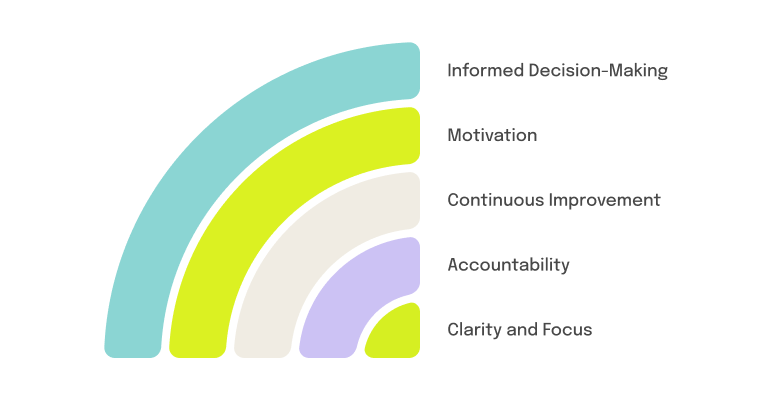
1. Clarity and Focus
One of the biggest challenges in any project is staying focused on the right priorities. KPIs serve as a filter, separating what truly drives results from the endless noise of day-to-day tasks. When KPIs are clearly defined, they act as a north star—helping teams see not just what to do but why it matters.
This alignment ensures that marketing, operations, product, and leadership are all rowing in the same direction, avoiding the costly trap of working hard on things that don’t move the needle.
2. Accountability
Without KPIs, accountability can easily become subjective—based on opinions, perceptions, or even office politics. KPIs replace guesswork with facts. When performance is quantified, it’s much easier to identify strengths and weaknesses objectively.
This doesn’t just hold individuals accountable; it also creates a culture where teams are evaluated fairly and transparently, making collaboration smoother and trust stronger.
3. Continuous Improvement
KPIs aren’t static—they tell a story over time. By tracking trends, teams can spot patterns: recurring delays, workloads that consistently overwhelm certain members, or stages of a project that always become bottlenecks.
This feedback loop is invaluable because it allows leaders to move from reactive problem-solving (“Why are we behind schedule again?”) to proactive improvements (“Let’s rebalance tasks earlier next sprint”). In other words, KPIs transform setbacks into opportunities for growth.
4. Motivation
When progress is invisible, motivation often fades. KPIs turn invisible effort into visible achievement. Seeing a chart improve or a performance score rise creates tangible proof that hard work pays off.
For example, a team watching their on-time completion rate climb from 60% to 85% feels a collective sense of accomplishment—fueling the motivation to push even higher. KPIs can be as much about celebrating wins as they are about spotting gaps.
5. Informed Decision-Making
Data-driven decisions are always stronger than gut feeling alone. KPIs provide leaders with the evidence needed to allocate resources, refine strategies, and adapt to changing circumstances. If data shows that tasks are consistently late due to resource shortages, leaders can justify hiring additional staff or reassigning workloads.
If KPIs reveal consistent overperformance, managers can confidently push for more ambitious targets. In short, KPIs give decision-makers the confidence to act with clarity, not uncertainty.
Without KPIs, teams risk moving forward blindly—expending effort without knowing whether they’re closer to success or just spinning their wheels. With KPIs, progress becomes visible, measurable, and actionable.
Step-by-Step Guide to Setting Up KPI Tracking in Quire
Now let’s move from theory to practice. Quire, a collaborative project management platform, offers powerful customization features to help teams define, track, and visualize KPIs in real time.
Here’s a step-by-step process to set up performance KPI tracking in Quire:
Step 1: Create a Custom Field for KPI Calculation
For tracking task performance, create a column in the custom field, name it KPI Point, apply the following formula, and choose the format as Number.
COUNT(assignees) * ((due = null) ?? false ? null: status < 100 ? (due < <today>) ? -2: 0: (completedAt < due) ? 1: -1)COUNT(assignees) * ((due = null) ?? false ? null: status < 100 ? (due < <today>) ? -2: 0: (completedAt < due) ? 1: -1)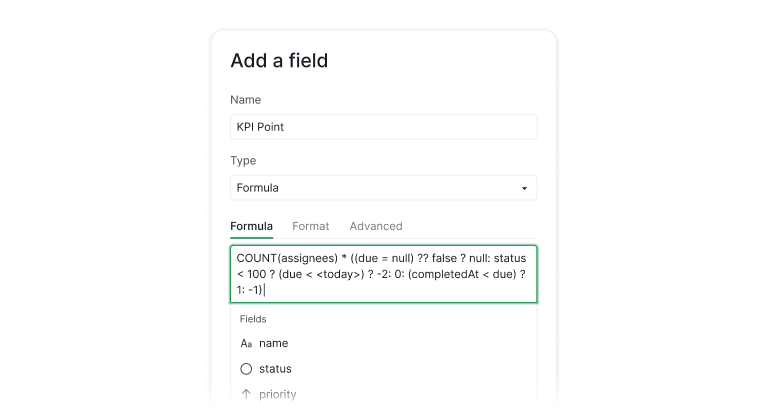
Here’s what this formula does:
- 1 point → if the task is completed before the due date.
- - 1 point → if the task is completed after the due date.
- - 2 points → if the task is overdue and not completed.
- 0 points → if the task is not executed yet but still within the due time.
This system creates a performance scoring model for every task assigned.
Step 2: Apply KPI Tracking Across Tasks
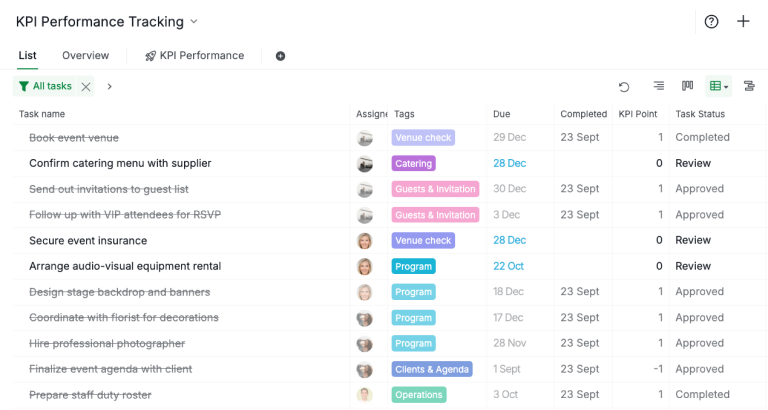
Once the field is created, all of the tasks with due and complete dates in your project will be applied with the KPI Point. Every task will now automatically carry a performance score based on completion status and timing.
This gives you a quick way to assess:
- Which team members consistently complete tasks on time.
- Which projects are running into delays.
- Where overdue tasks are piling up.
Step 3: Visualize KPI Data With Charts
Numbers are useful, but visuals make KPIs actionable. In Quire, you can generate charts to visualize KPI trends over time.
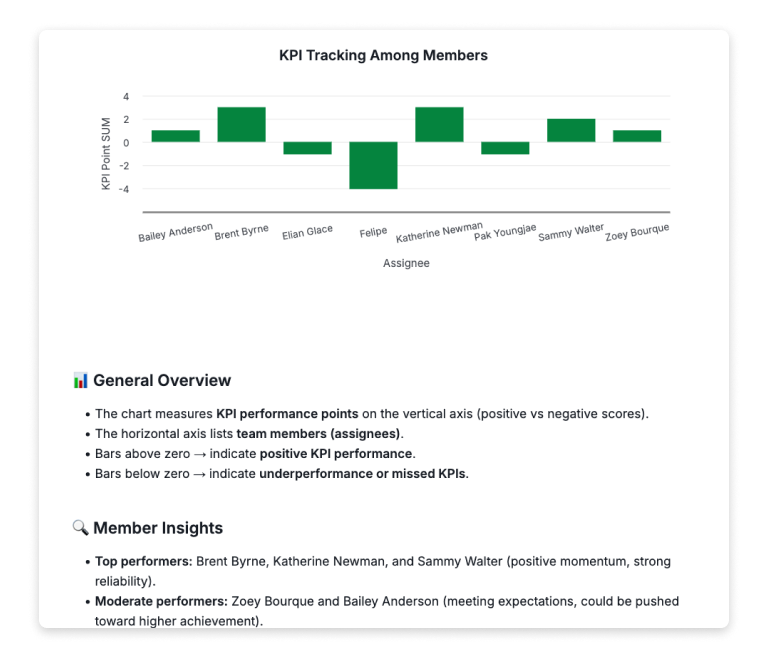
For example:
- Pie Chart → Visualize the task count breakdown by task categories.
- Stacked Bar Chart → Visualize the work progress status
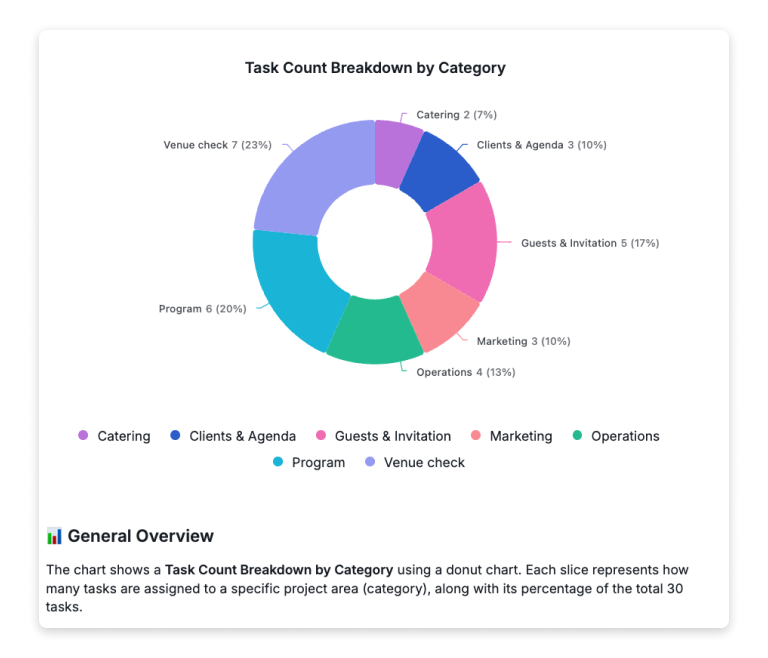
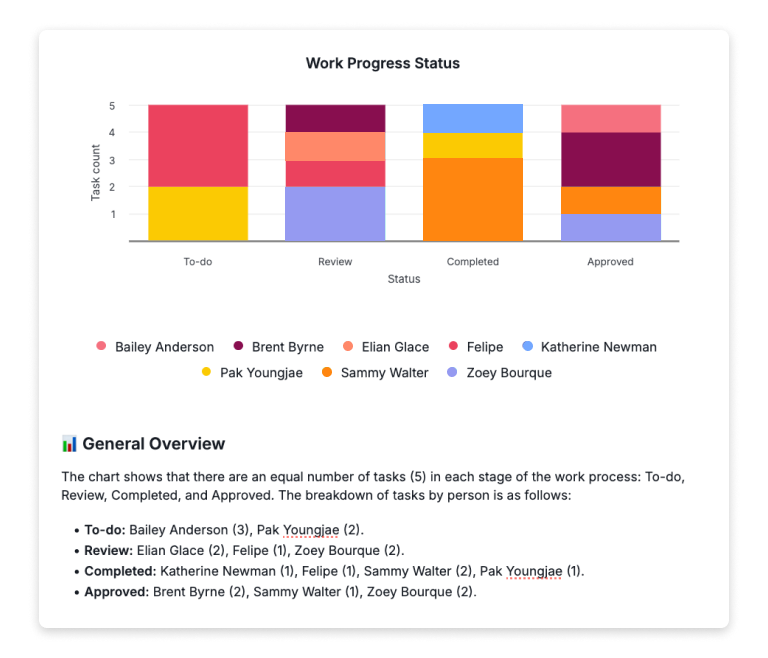
This makes it easy for managers to identify patterns. For instance, if a team’s KPI scores are consistently low in the last two weeks, it may signal workload imbalance or resource issues.
Step 4: Review and Adjust
KPI tracking isn’t “set and forget.” Use Quire’s reporting and charting features to review progress regularly. If the formula or scoring doesn’t reflect reality, adjust it.
For example, you could assign different weights to tasks based on priority or complexity.
If you’d like to access the KPI Tracking Template, please visit our template site.
Quantify Your Team’s Performance to Drive Future Success!
KPIs aren’t just about measuring numbers—they’re about driving performance, aligning teams, and achieving goals with clarity.
When defined correctly, they help teams focus on what matters most, deliver accountability, and fuel continuous improvement. And with tools like Quire, setting up and tracking KPIs doesn’t have to be complex. By creating custom fields, applying formulas, and visualizing data through charts, teams can turn raw data into actionable insights.
If you’re ready to improve your team’s performance management, start by defining meaningful KPIs—and let Quire do the heavy lifting when it comes to tracking them.

